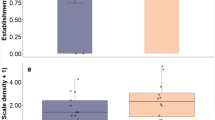Abstract
The guild of “cosmopolitan” Drosophila coexist almost worldwide and yet the mechanisms that underlie this coexistence are unknown. The larval resource of the guild is decaying fruit and vegetables, but the species show little specialization and can coexist on a single resource, such as oranges. In southern California the guild includes D. simulans (SIM), D. melanogaster (MEL), D. pseudoobscura (OBS), D. immigrans (IMM), D. hydei (HYD) and D. busckii (BUS). These species show consistent differences in their colonization of decaying organges, differences that may promote their coexistence. This study tested whether the colonization pattern of a species is determined primarily by attraction to specific resource types (decayed or fresh organges), by ability to colonize new resource patches, or by dependence on a successional sequence of Drosophila species. The experiments compared oranges that were pre-aged prior to a colonization period and showed that the colonization pattern of each species (except OBS) was driven primarily by its decay-dependent attraction to oranges. While OBS exhibited a pattern of colonization independent of pre-aging, the remaining species all showed some preference for older (7-day pre-aged) over fresh oranges. Their overall pattern of attraction, ordered by high relative abundance on fresher organges, was SIM>MEL=IMM>HYD=BUS. BUS, a specialist on decaying plant material, was the only species that showed a preference for 11-day over 7-day oranges. Pre-aging the oranges under covers, to prevent prior colonization by Drosophila, did not change the interspecific pattern of colonization, indicating that microbial decay was driving the changes in attraction. The patterns of attraction separated two ecologically similar pairs (SIM from MEL; IMM from HYD) and published data on ethanol tolerance show that, in each pair, the earliest colonizer has the lower tolerance. This suggests an important interplay between colonization patterns and physiological optima.
Similar content being viewed by others
References
Atkinson WD (1979) A comparison of the reproductive strategies of domestic species of Drosophila. J Anim Ecol 48:53–64
Atkinson WD (1981) An ecological interaction between citrus fruit, Penicillium moulds and Drosophila immigrans Sturtevant (Diptera: Drosophilidae). Ecol Entomol 6:339–344
Atkinson WD, Shorrocks B (1977) Breeding site specificity in the domestic species of Drosophila. Oecologia 29:223–232
Arthur W (1980a) Interspecific competition in Drosophila I. Reversal of competitive superiority due to varying concentration of ethanol. Biol J Linn Soc 13:109–118
Arthur W (1980b) Interspecific competition in Drosophila. II. Competitive outcome in some 2-resource environments. Biol J Linn Soc 13:119–128
Arthur W, Middlecote J (1987) Frequency-dependent competitive abilities and differential resource use in competition between D. hydei and D. melanogaster. Biol J Linn Soc 23:167–176
Burla H (1955) The order of attraction of Drosophila species to cut palm trees. Ecology 36:153–155
Clements FE (1936) Nature and structure of the climax. J Ecol 24:252–284
Fellows DP, Heed WB (1972) Factors affecting host plant selection in desert-adapted cactophilic Drosophild. Ecology 53:850–858
Fogleman JC, Hackbarth KR, Heed WB (1981) Behavioral differentiation between two species of cactophilic Drosophila. III. Oviposition site preference. Am Nat 118:541–548
Gibson JB, May TW, Wilks AV (1981) Genetic variation at the al cohol dehydrogenase locus in Drosophila melanogaster in relation to environmental variation: ethanol levels in breeding sites and allozyme frequencies. Oecologia 51:191–198
Grimaldi D, Jaenike J (1984) Competition in natural populations of mycophagous Drosophila. Ecology 65:1113–1120
Heed WB (1971) Host plant specificity and speciation in Hawaiin Drosophila. Taxon 20:115–121
Heed WB (1978) Ecology and genetics of Sonoran desert Drosophila. In: Brussard PF (ed) Ecological genetics: the interface. Springer, Berlin Heidelberg New York, pp 109–126
Hoffman AA (1985) Interspecific variation in the response of Drosophila to chemicals and odours in a wind tunnel. Aust J Zool 33:451–460
Kaneshiro KY, Carson HL, Heed WB (1973) Niche separation in a pair of homosequential Drosophila species from the island of Hawaii. Am Nat 107:766–774
Lachaise D (1977) Niche separation of African Lissocephala with-in the Ficus drospohilid community. Oecologia 31:201–214
Lachaise D, Tsacas L, Couturier G (1982) The Drosophilidae associated with tropical African figs. Evolution 36:141–151
McKechnie SW, Morgan P (1982) Alcohol dehydrogenase polymorphism of Drosophila melanogaster. Aspects of alcohol and temperature variation in the larval environment. Aust J Biol Sci 35:85–93
McKenzie JA, Parsons PA (1972) Alcohol tolerance: an ecological parameter in the relative success of Drosophila melanogaster and Drosophila simulans. Oecologia 10:373–388
McKenzie JA, McKechnie SW (1979) A comparative study of resource utilization in natural populations of Drosophila melanogaster and D. simulans. Oecologia 40:299–309
Merçot H, Defaye D, Capy P, Pla E, David JR (1994) Alcohol tolerance, ADH activity, and ecological niche of Drosophila species. Evolution 48:746–757
Nunney L (1990) Drosophila on oranges: colonization, competition and coexistence. Ecology 71:1904–1915
Oakeshott JG, May TW, Gibson JB, Willcocks DA (1982) Resource partitioning in five domestic Drosophila species and its relationship to ethanol metabolism. Aust J Zool 30:547–556
Pipkin SB, Rodriguez RL, Leon J (1966) Plant host specificity among flower-feeding neotropical Drosophila (Diptera: Drosophilidae). Am Nat 100:135–156
Prince GJ, Parsons PA (1980) Resource utilization specificity in three cosmopolitan Drosophila species. J Nat Hist 14:559–565
Sevenster JG, Alphen JJM van (1993a) Coexistence in stochastic environments through a life history trade off in Drosophila. Lecture Notes Biomath 98:155–172
Sevenster JG, Alphen JJM van (1993b) A life history trade-off in Drosophila species and community structure in variable environments. J Anim Ecol 62:720–736
Shorrocks B, Atkinson W, Charlesworth P (1979) Competition on a divided and ephemeral resource. J Anim Ecol 48:899–908
Shorrocks B, Bingley M (1994) Priority effects and species coexistence: experiments with fungal-breeding Drosophila. J Anim Ecol 63:79–806
Sokal RR, Rohlf FJ (1994) Biometry, 3rd edn. Freeman, New York
Wallace B (1975) The biogeography of laboratory islands. Evolution 29:622–635
Author information
Authors and Affiliations
Rights and permissions
About this article
Cite this article
Nunney, L. The colonization of organges by the cosmopolitan Drosophila . Oecologia 108, 552–561 (1996). https://doi.org/10.1007/BF00333733
Received:
Accepted:
Issue Date:
DOI: https://doi.org/10.1007/BF00333733




